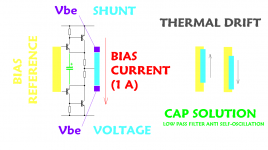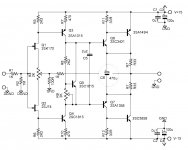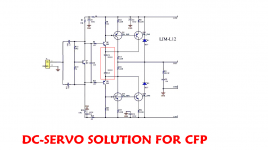better image
a better image
a better image
An externally hosted image should be here but it was not working when we last tested it.
Lumba Ogir said:VHF man,
CFP output is of crucial importance, CFP driver/EF output... not that exiting. It is about distortion in the output stage.
Yes but much of what we attribute to output stage distortion is actually due to non linear VAS loading (several reasons) and this usualy produces higher order products. A purely bipolar CFP output stage will measure very well but from my experience (and depending on VAS design) may not sound as good as a darlington EF output stage that measures worse. Analysis of the distortion spectral distribution can show what's going on.
FTR, one of my best sounding amps uses a single ended VAS and CFP output stage with fast bipolar drivers and lateral mosfet outputs. THD measurements are also excellent but the VAS output impedance needs to be low (< 150 ohms) above 1KHz to negate non linear VAS loading mainly from gm doubling.
Just a note here too on layout. Unless you're prepered to employ an RF ground plane and magnetic shielding in critical supply feeds etc, you will more than likely have stability issues or degraded THD performance, regardless of design. If you want really high end performance then actual CCT (schematic) design is only about 50% of the result.
I'll send some shematics and photos of layout in the next day or so to illustrate.
VHF man,
A purely bipolar CFP class AB?A purely bipolar CFP output stage will measure very well but from my experience (and depending on VAS design) may not sound as good as a darlington EF output stage that measures worse. Analysis of the distortion spectral distribution can show what's going on.
That`s very nice, isn`t it. An EF predriver is necessary. What do you dislike about the configuration of the Suplifier output stage?one of my best sounding amps uses a single ended VAS and CFP output stage with fast bipolar drivers and lateral mosfet outputs.
ionomolo said:
What? This is a result from your experiments? What i did understand is that the Sziklai output posed an extra advantage in class B: The crossover region is reduced from 1.4V to 0.7.
I doesn't work that way. The CFP was a wider crossover region and the crossover distortion is significantly higher.
This is noted by both D.Self and Randy Slone.
Cheers,
Glen'
Lumba Ogir said:VHF man,
A purely bipolar CFP class AB?
That`s very nice, isn`t it. An EF predriver is necessary. What do you dislike about the configuration of the Suplifier output stage?
Sorry, yes I do mean class AB. I have no issues with CFP class A and in fact my pre amplifier and headphone amplifier all employ bipolar CFP class A output stages. The issues I have relate to the class AB performance. However I should qualify this by saying that my issues also apply more to low impedance load requirements where multiple parallel devices are needed. A CFP output stage obviously does not lend itself to simple current sharing so device matching becomes more critical. I think the main weaknesses of bipolar pa CFP in class AB have been well explored in other forum threads so there's little point restating them again here but suffice to say that IMO a rule of thumb is bipola CFP in class A fine in all respects while bipolar darlington EF is the best all round solution for class AB. If you extrapolate from there, there's no reason why a class A CFP stage cannot be used as a high hfe EF driver stage feeding a single stage bipolar EF output. This gives similar hfe to a triple darlington but with only 2 x vbe drops, which means lower thd and greater thermal stability. The only real drawback of this approach is the high-ish driver stage power dissipation which necessitates mounting the CFP driver output devices on a large heatsink. There are several other advantages though. Such a configuration also allows loop feedback from the driver stage for those who wish to experiment with variations on the global feedback theme including an additional compensation pole.
sorry guys .....
but i really dont get this ......
all this theory lay out i see above has anything to do with the original post ???? or the particular problem ????
they way you built this thread should be called (TECHNIQUES ON AMPLIFIER DESIGN ) or so
i actually find all this very usefull since opinion from real experts is discussed here but dont really think that has anything to do with the original thread ....
happy regards sakis
but i really dont get this ......
all this theory lay out i see above has anything to do with the original post ???? or the particular problem ????
they way you built this thread should be called (TECHNIQUES ON AMPLIFIER DESIGN ) or so
i actually find all this very usefull since opinion from real experts is discussed here but dont really think that has anything to do with the original thread ....
happy regards sakis
Re: sorry guys .....
I consider myself an amateur audio designer and constructor (hobbyist), definitely no expert. IMO I think comments or advise from anyone be they expert, intermediate or novice are all valuable. There is no one audio oracle to learn from. And anyway the enjoyment is in the journey and not the destination.
Sorry to corrupt or at least continue the corruption of this thread, but then again it's difficult to find any long thread that remains intact from S to F.
sakis said:but i really dont get this ......
all this theory lay out i see above has anything to do with the original post ???? or the particular problem ????
they way you built this thread should be called (TECHNIQUES ON AMPLIFIER DESIGN ) or so
i actually find all this very usefull since opinion from real experts is discussed here but dont really think that has anything to do with the original thread ....
happy regards sakis
I consider myself an amateur audio designer and constructor (hobbyist), definitely no expert. IMO I think comments or advise from anyone be they expert, intermediate or novice are all valuable. There is no one audio oracle to learn from. And anyway the enjoyment is in the journey and not the destination.
Sorry to corrupt or at least continue the corruption of this thread, but then again it's difficult to find any long thread that remains intact from S to F.
- Status
- This old topic is closed. If you want to reopen this topic, contact a moderator using the "Report Post" button.
- Home
- Amplifiers
- Solid State
- Sziklai output


